Environment: milieu / climate zone / depth range / distribution range
Ecologie
marien demersaal. Tropical
Western Pacific.
Grootte / Gewicht / Leeftijd
Maturity: Lm ? range ? - ? cm
Anteriormost 3 dorsal-fin spines originates over or immediately behind eye and widely separated from the remainder of the fin. Body smooth; covered with numerous elongate cirri, especially anteriorly. Lachrymal weakly ossified, without spine (Ref. 39602).
Levenscyclus en paargedrag
Maturiteit | Voortplanting | Paaien | Eieren | Fecunditeit | Larven
Poss, S.G., 1999. Aploactinidae. Velvetfishes. p. 2354-2358. In K.E. Carpenter and V.H. Niem (eds.) FAO species identification guide for fishery purposes. The living marine resources of the Western Central Pacific. Vol. 4. Bony fishes part 2 (Mugilidae to Carangidae). Rome, FAO. 2069-2790 p. (Ref. 39602)
Status op de Rode Lijst van het IUCN (Ref. 130435: Version 2024-2)
Gevaar voor de mens
Harmless
Gebruik door de mens
Tools
Speciale rapporten
Download XML
Internetbronnen
Estimates based on models
Preferred temperature (Ref.
123201): 25 - 29.3, mean 28.7 °C (based on 406 cells).
Fylogenetische diversiteitsindex (Ref.
82804): PD
50 = 1.0000 [Uniqueness, from 0.5 = low to 2.0 = high].
Bayesian length-weight: a=0.01288 (0.00419 - 0.03963), b=3.03 (2.77 - 3.29), in cm total length, based on LWR estimates for this (Sub)family-body shape (Ref.
93245).
Trofisch niveau (Ref.
69278): 3.3 ±0.3 se; based on size and trophs of closest relatives
Fishing Vulnerability (Ref.
59153): Low vulnerability (10 of 100).
